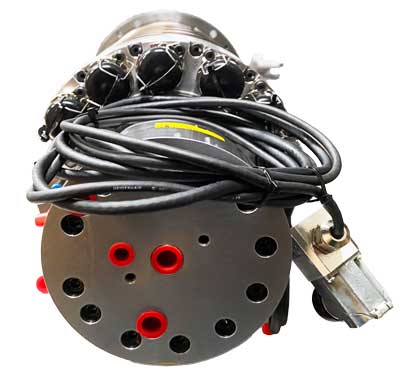We have mentioned spindle storage in recent blogs and got a few questions about it, so we decided it was time to address the topic in a blog.
Whenever a manufacturer runs a machine with spindles, they do — or definitely should — have a backup spindle on-hand. The backup is there so that the machine can still be run while the primary spindle is maintained or repaired, minimizing costly downtime. When that spindle returns, it becomes the spare and is kept on hand until needed.
 Most people, even those with good amounts of machining experience, are perfectly happy to keep those spare spindles on a nearby shelf. Rarely is a great deal of thought put into how or where they’re stored.
Most people, even those with good amounts of machining experience, are perfectly happy to keep those spare spindles on a nearby shelf. Rarely is a great deal of thought put into how or where they’re stored.
The fact is, though, that how a spindle is stored can have a great deal of impact on its performance and lifespan.
Spindle Storage Dos
There are three main things that you want to do when storing your spindles.
The first is to ensure that every single port and service hole is firmly plugged. Anything that finds ingress into a spindle — be it dust, moisture, metal shavings, or any other form of particulate contamination — can cause damage and will not be easy to remove.
The second is to make sure that your spindle is wrapped very well in oil paper, with desiccants placed inside the wrapping. The same way that moisture is the enemy to the inside of your spindle, it’s the enemy to the exterior as well. Using desiccants will help wick away moisture. Using proper wrapping material and technique and block new moisture from getting in, minimizing the chances of rust development and other contamination.
 A good spindle repair firm is going to deliver your spindles to you already plugged and wrapped. The third Do of spindle storage is entirely up to you — and that Do is to rotate your spare spindle’s shaft regularly.
A good spindle repair firm is going to deliver your spindles to you already plugged and wrapped. The third Do of spindle storage is entirely up to you — and that Do is to rotate your spare spindle’s shaft regularly.
Leaving a spare spindle to sit completely idle is one of the worst things you can do. Over time gravity pushes down the ball bearings and displaces lubricant. This leads to direct metal-on-metal contact in the spindles bearings which, if left, will lead to microwelding. When a microwelded spindle is put into service, the ball bearings catch on those imperfections and greatly hasten wear. Microwelding leads to surface roughening, lubricant breakdown, loss of performance and ultimately, failure.
Spindle Storage Don’ts
We prefer to stay positive, but some aspects of proper spindle storage require you to avoid certain things, rather than take proactive actions.
The first Don’t to spindle storage is do not store it anywhere that it can be subjected to excessive or sustained vibration. Though a spindle’s work naturally subjects it to vibrations, a static spindle is extremely vulnerable to those same forces. Vibrations transfer quickly and efficiently through a stationary spindle, causing damage to the metal. Worsening the effect is that lubrication tends to settle, leading to more direct metal-to-metal contact.
The second Don’t is do not store in an environment that experiences large fluctuations in temperature. This is another largely lubricant-based consideration. When subjected to extreme or sudden shifts in temperature, the properties of the lubricant actually change. Repeating these stresses will lead to the lubricant degrading much quicker than normal. Further, when puting the spindle back into service, let it acclimate before flipping the switch.
The ideal temperature range for spindle storage is between 65°F and 120°F. But again, stability is key — if your storage area regularly fluctuates between 70°F and 110°F, even though that is technically within the safe temperature range, the lubricant will degrade. Stable temperatures within the safe temperature range are ideal.
That’s about all there is to it. If these all seem like common sense practices to you, good! That means you’ve been storing your spindles correctly. But for every one person who reads this and thinks “Obviously,” there are a few who never gave their spindle storage practices a second thought.
